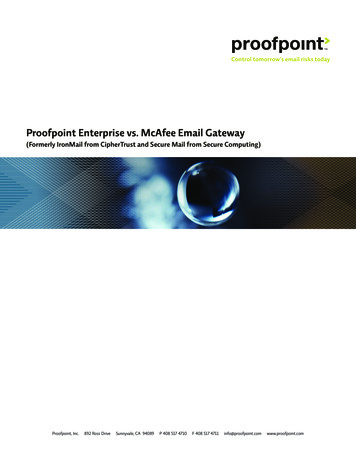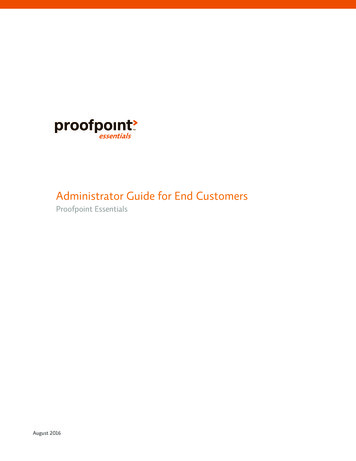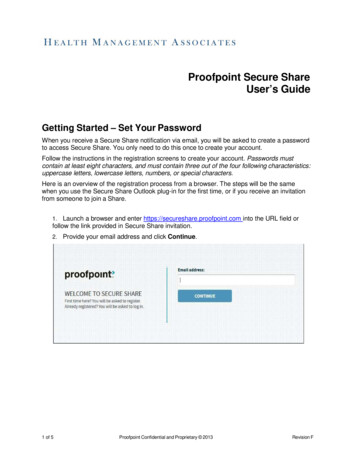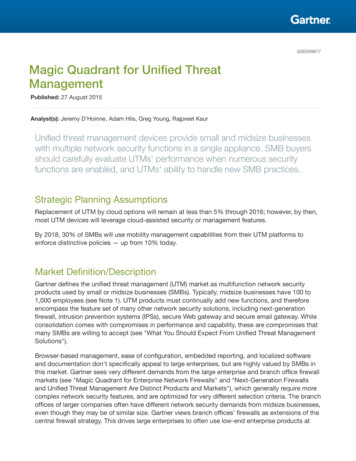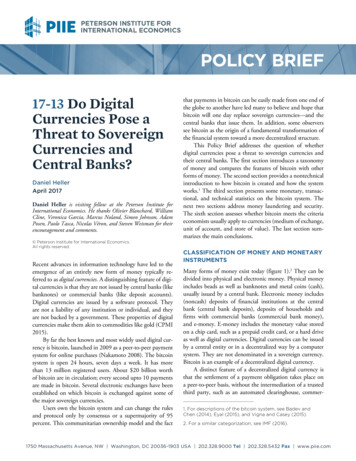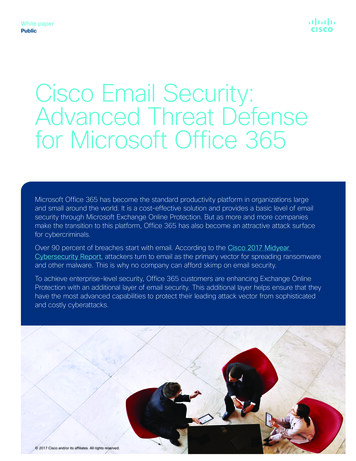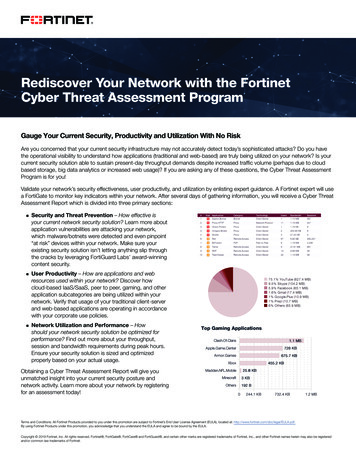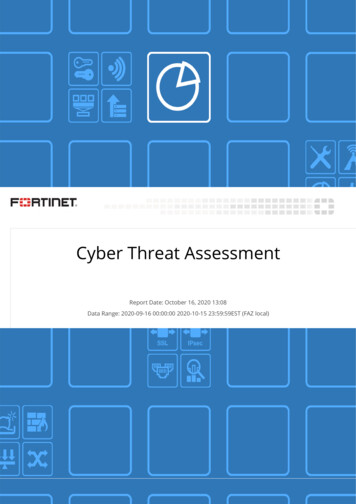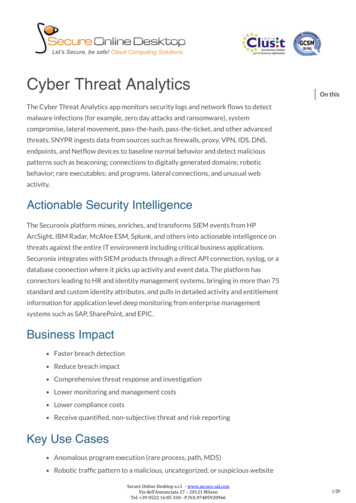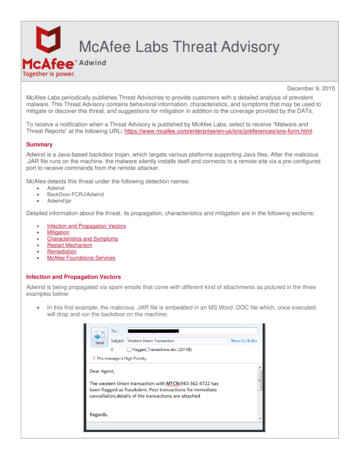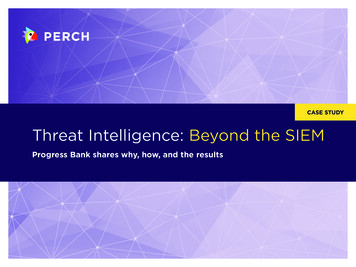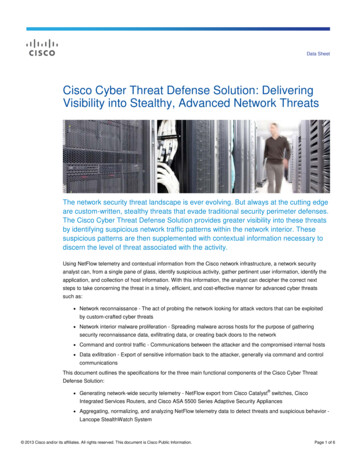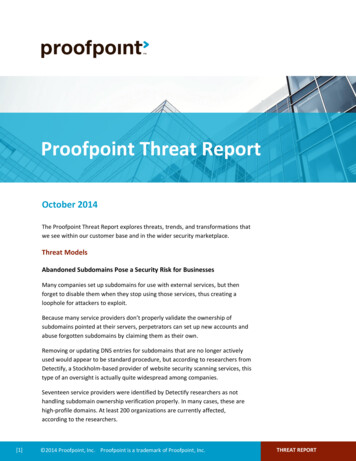
Transcription
\Proofpoint Threat ReportOctober 2014The Proofpoint Threat Report explores threats, trends, and transformations thatwe see within our customer base and in the wider security marketplace.Threat ModelsAbandoned Subdomains Pose a Security Risk for BusinessesMany companies set up subdomains for use with external services, but thenforget to disable them when they stop using those services, thus creating aloophole for attackers to exploit.Because many service providers don’t properly validate the ownership ofsubdomains pointed at their servers, perpetrators can set up new accounts andabuse forgotten subdomains by claiming them as their own.Removing or updating DNS entries for subdomains that are no longer activelyused would appear to be standard procedure, but according to researchers fromDetectify, a Stockholm-based provider of website security scanning services, thistype of an oversight is actually quite widespread among companies.Seventeen service providers were identified by Detectify researchers as nothandling subdomain ownership verification properly. In many cases, these arehigh-profile domains. At least 200 organizations are currently affected,according to the researchers.[1] 2014 Proofpoint, Inc. Proofpoint is a trademark of Proofpoint, Inc.THREAT REPORT
The risk to website owners depends on what can be done on a third-partyservice once a domain is pointed to it. If the service allows users to set up Webpages or Web redirects, attackers can exploit the situation to launch crediblephishing attacks by creating rogue copies of the main website.According to Detectify, some of the subdomains exposed to this form ofhijacking belonged to various types of organizations, including governmentagencies, health service providers, insurance companies, and banks.The security firm created an online tool (https://redoctober.detectify.com/)that can help organizations check their subdomains for vulnerability to thisattack. Note that the tool first requires users to prove they have control overthe domains to be scanned.Hackers Target ATMs in Russia, Eastern EuropeNot only are cybercriminals targeting the computer systems of big banks, butthey’re also firing at their ATM machines, especially in Eastern Europe andRussia.Researchers for Kaspersky Lab, a security company, and INTERPOL, the world’slargest international police organization, say they have discovered malicioussoftware allowing criminals to empty cash machines. The company said that atthe request of a financial institution it began a forensic examination into thehack of multiple ATMs in Eastern Europe and Russia. (The institution remainednameless.)At the time of the investigation, around March of this year, the malware wasactive on more than 50 ATMs at banking institutions in Eastern Europe andRussia. According to Kaspersky, the malware has spread to the US, Israel,Malaysia, France, India, and China. As ATMs are not connected to the Internet, itmay not be possible to register attacks unless the victimized banks report them.Video footage obtained from security cameras at infected ATMs shows that thehacks occur at night, and only on Sundays and Mondays. Furthermore, themalware only accepts commands at specific times on Sunday and Mondaynights.The criminals insert a bootable computer disk loaded with malicious softwareinto the system. The ATM is then rebooted, at which point the software isuploaded to the ATM’s system. Once the ATM is rebooted a second time, thecriminals enter a unique combination of digits (every time) on the ATM’skeyboard. Another set of numbers is entered after a phone call is made by thehacker (on-site) to an operator to receive further instructions.Four minutes later, the ATM starts dispensing cash.[2] 2014 Proofpoint, Inc. Proofpoint is a trademark of Proofpoint, Inc.THREAT REPORT
Mr. Kaspersky said his company is now assisting Russian police, and INTERPOLhas alerted the affected member countries. Investigations are ongoing.Threat NewsHow One Criminal Hacker Group Stole Credentials for 800,000 BankAccountsA new report from Proofpoint shows the increasing sophistication of cybercrimeinfrastructure. Proofpoint reports that one Russian-speaking criminalorganization employed third-party services, used technology and services topromote the efficacy of adjusting to business security challenges, and evencreated alternate revenue streams for itself in order to commit the theft.To begin the process, the attackers purchased lists of stolen administrator loginsfor WordPress sites. They then uploaded malware to those sites.Click here for the next disturbing steps in the ank-accounts/d/d-id/1316484.Microsoft Windows Zero-Day Vulnerability (CVE-2014-4114) Used byRussian Espionage Group “SandWorm”A zero-day vulnerability impacting all supported versions of Microsoft Windowsand Windows Server 2008 and 2012 has been discovered and revealed byiSIGHT Partners, in close collaboration with Microsoft. A patch was madeavailable for this vulnerability on Tuesday, October 14.Whether the SandWorm team is working on behalf of the Russian governmentor attempting to misdirect investigators by appearing to do so, its behavior doesappear to be connected to some “professional government or nation-statemission,” said Philip Lieberman, president of Lieberman Software. Nation-states“only use their highest value assets against high-value targets.”If exploited, the flaw would let attackers remotely execute code on targetsystems.Known targets include campaigns against: l Services Rank Cyberattacks Top Industry WorryA recent report published by the Depository Trust & Clearing Corporation forthe third quarter of 2014 found that 84% of financial firms ranked cyber risk as[3] 2014 Proofpoint, Inc. Proofpoint is a trademark of Proofpoint, Inc.THREAT REPORT
one of their top five concerns, up from 59% in the first quarter of this year.Immediately following in the top five are: Impact of New Regulations (64%)Geopolitical Risk (62%)Sudden Dislocation in Financial Markets (43%)Disruption/Failure of a Key Market Participant (32%)Note that some 76% of financial firms say that over the past year, they haveadded more resources for detection and mitigation of systemic risks.Read the article in its entirety: d/did/1316917?Threat Insight BlogHere we highlight interesting posts from Proofpoint’s threat blog, Threat Insight.Subscribe to Threat Insight and join the conversation athttp://www.proofpoint.com/threatinsight.Calendar Spam Invites TroubleSurges of old but familiar phishing and spam templates re-emerge every nowand then. Techniques that we would expect to be too old to remain effectiveagainst modern filters are oftentimes resurrected. A recent spike of calendarspam typifies this situation.This spam variant can still be effective because many filters do not consistentlyblock calendar invites (*.ics). Also, routing from legitimate domains makes themessages more likely to evade sender-reputation filters.Have a look at an example of calendar spam detected during the recent s/calendar-spam-invitestrouble.phpDyreza Takes StockThe banking malware called “Dyreza” or “Dyre” uses a man-in-the-middle attackthat lets the hacker intercept unencrypted Web traffic while users mistakenlybelieve the connection they have with their online banking site is secure.This malware has been implicated recently in multiple large-scale phishingcampaigns and is expanding its reach to target users of cloud services, such asSalesforce. Dyreza uses a technique called “browser hooking” to viewunencrypted Web traffic. The operation involves compromising a computer,[4] 2014 Proofpoint, Inc. Proofpoint is a trademark of Proofpoint, Inc.THREAT REPORT
capturing unencrypted traffic, and then stepping in when a user tries to make asecure SSL (Secure Sockets Layer) connection with a website.Dyreza has undergone a few changes recently and Proofpoint securityresearchers have been right there to analyze them. The new features arehighlighted here: za-takesstock.phpThreat TrendsSpam Volume TrendsProofpoint tracks spam volumes via a system of honeypots. The volumeshistorically track with that of our customer base. October’s daily spam volumewas erratic, with moderate highs and lows through the very end of the month.Beginning with roughly 5 million and a gradual dip to 3 million, the start of thesecond week saw a dramatic shift to well over 6 million and then dipped tounder 4 million by midweek. A gradual increase to the highest point of themonth, 7 million, occurred at the close of the third week. The fourth weekleveled off at 4 million. A sudden spike to just above 6 million nearly capped themonth, before ending in another decline to a bit over 3 million.MillionsDaily Message Volume - October 201487654321010/1[5]10/810/1510/22 2014 Proofpoint, Inc. Proofpoint is a trademark of Proofpoint, Inc.10/29THREAT REPORT
By comparison, September-over-October demonstrated the most dramaticdecrease in the volume of spam (32.38%) since November of last year (38.17%).The year-over-year spam tally decreased 43.10% in volume.Daily Message Volume - Nov 2013 to Oct 14May-14Apr-14Mar-14Feb-14Jan-14Dec-13Nov-130Spam Sources by CountryIn an unprecedented move, China captured the top position in October. The EUslipped to second by a small margin for the first time since March of 2013. Atthat time, the EU placed third. Russia reentered the mix for the first time sinceAugust of 2014 to steal third, while Vietnam and the USA captured fourth andfifth, respectively.RankThe following table shows the top five spam-sending continents and countriesfor the last six ussiaChinaKoreaUSA 2014 Proofpoint, Inc. Proofpoint is a trademark of Proofpoint, Inc.THREAT REPORT
The table below details the percentage of total spam volume for the Septemberand October 2014 rankings noted above. The calculation for the EU is based onthe inclusion of all member states, thereby producing a better representation ofits volume. At 18.82%, China generated the majority of the world’s spam. Theremaining four countries in the top five slots were collectively responsible for33.61%—nearly double the output of China.12345September 2014EU24.99%Vietnam 13.36%China4.51%Argentina 3.68%Korea3.66%12345October 2014China18.82%EU15.61%Russia9.25%Vietnam 5.10%US3.65%For additional insights visit us atwww.proofpoint.com/threatinsightProofpoint, Inc.892 Ross Drive, Sunnyvale, CA 94089Tel: 1 408 517 4710www.proofpoint.com[7] 2014 Proofpoint, Inc. Proofpoint is a trademark of Proofpoint, Inc.THREAT REPORT
The criminals insert a bootable computer disk loaded with malicious software into the system. The ATM is then rebooted, at which point the software is uploaded to the ATM’s system. Once the ATM is rebooted a second time, the criminals enter a unique
